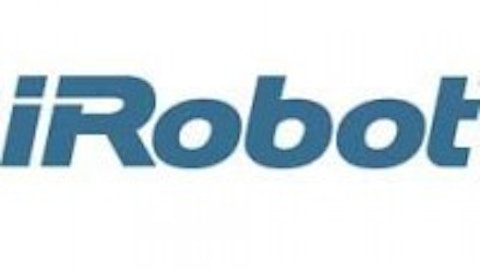
The New York Stock Exchange — the larger part of NYSE Euronext (NYSE:NYX) — moved into its present home on 18 Broad Street (on the corner of Broad and Wall Street) on April 22, 1903. It was an architectural marvel for its time, with a massive open trading floor without any supporting columns, huge windows, six miles of pneumatic tubes for routing orders, and one of the world’s first air-conditioning systems. Even if you’ve never visited this iconic location, you’re probably well-acquainted. It is one of the most famous buildings in the world:

Source: Dave Winer via Flickr.
The Exchange also has one of the most iconic sculptures in the world standing near its doors, called simply Charging Bull. The bronze statue in Bowling Green has become a symbol of New York’s financial sector ever since it was installed following the 1987 market crash:

Source: Rob Jamieson via Flickr.
Where else might you have seen the current building? Well, beyond the many market-focused films, you might have seen Bane hijack the “Gotham Stock Exchange” in The Dark Knight Rises. Those scenes were shot in the New York Stock Exchange building. Bane’s efforts have been compared to the modus operandi of Occupy Wall Street, and those protests were localized near the exchange. So many protestors camped out near the bull sculpture that it remained fenced off for months after the protests ended.
Many companies choose to visit the New York Stock Exchange to ring the ceremonial opening bell when they complete an IPO, and these events now bring some of the largest crowds to a largely automated exchange. After all, billions of daily trades couldn’t be handled by a bunch of stock jockeys yelling numbers at screens. The automation of the New York Stock Exchange has, unfortunately, had the side effect of making dramatic market moves less human, as there’s no longer a swarm of traders on the floor. Many of the market’s wildest days occurred before the advent of computerized trading, when hundreds or thousands of traders and support staff made frantic efforts to profit (or at least minimize their losses):
March 15, 1933: The Dow Jones Industrial Average (Dow Jones Indices:.DJI) gains more than 15% after the resumption of trading following President Franklin D. Roosevelt’s bank holiday.
Oct. 19, 1987: Black Monday sends the Dow plummeting nearly 23%. Program trading (a precursor to high-frequency trading) is blamed, marking an unofficial shift toward remote electronic trading.
Oct. 28 and Oct. 29, 1929: The unofficial beginning of the Great Depression was this sharp two-day break that began the Crash of 1929. Traders were remarkably optimistic at the close of both days, despite the Dow Jones Industrial Average (Dow Jones Indices:.DJI)’s 23% loss.
However, that’s not to say that wild swings went away when the traders left the floor. Some of the Dow Jones Industrial Average (Dow Jones Indices:.DJI)’s wildest days occurred during the period near the dot-com bubble peak and during the financial crisis of 2008. These events simply occurred without the familiar trope of traders yelling “buy, buy!” or “sell, sell!” at 18 Broad Street as a backdrop.
A fiber upon the deep
General Telephone and Electronics (GTE, now a part of Verizon Communications Inc. (NYSE:VZ) ) completed the first commercial transmission through fiber-optic cables on April 22, 1977, when it routed some Long Beach, Calif., telephone traffic through a 6-megabit-per-second line. After decades of employing copper-based lines, telecommunications had finally stepped into the digital age.
Whether you’re viewing this article on a phone, a tablet, a laptop, or a PC, the data almost certainly reached you after zipping along fiber-optic cabling for most of its journey. Fiber optics became a hugely appealing subset of technological manufacturing during the dot-com boom, as it was predicted that the explosive growth of the Internet would require an enormous cable build-out to keep pace with data demands. Aided by rapid technological improvements, fiber-optic cable capacity exploded throughout the ’90s, and system capacity doubled every six months from 1992 to 2001 — a rate far outstripping the growth of computing power predicted by Moore’s Law.
Glassmaker Corning Incorporated (NYSE:GLW) soared nearly 500% from the start of 1998 to the peak of the dot-com bubble in early 2000 on hopes for its fiber-optic cable division. Corning Incorporated (NYSE:GLW) had grown into the world’s largest fiber-optics manufacturer, ahead of second-place Lucent and third-place Alcatel, which merged in 2006 to become Alcatel Lucent SA (ADR) (NYSE:ALU); the combined stock chart for these companies shows a double from 1998 to early 2000. Millions of miles of fiber-optic cabling now crisscross the globe, but that hasn’t helped either Corning Incorporated (NYSE:GLW) or Alcatel Lucent SA (ADR) (NYSE:ALU). The two largest fiber-optic manufacturers have suffered respective share-price declines of 70% and more than 90% since their peaks. Sometimes technological progress can be so fast that even its largest proponents lose out — at least for a while.
The article The Most Famous Building on Wall Street originally appeared on Fool.com and is written by Alex Planes.
Fool contributor Alex Planes holds no financial position in any company mentioned here. Add him on Google+ or follow him on Twitter @TMFBiggles for more insight into markets, history, and technology.The Motley Fool recommends Corning and NYSE Euronext. The Motley Fool owns shares of Corning.
Copyright © 1995 – 2013 The Motley Fool, LLC. All rights reserved. The Motley Fool has a disclosure policy.

